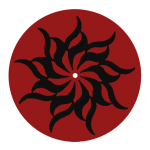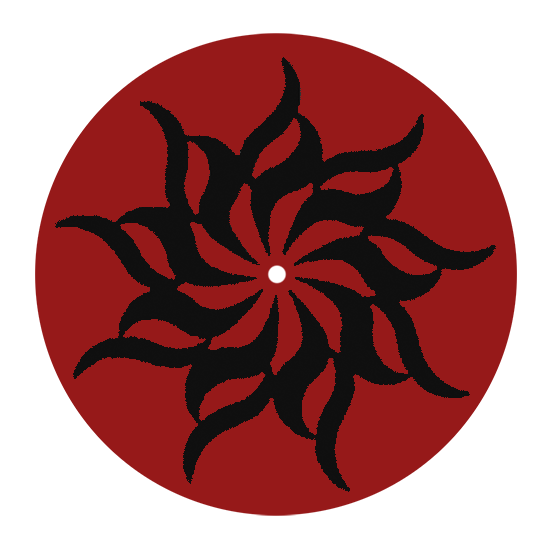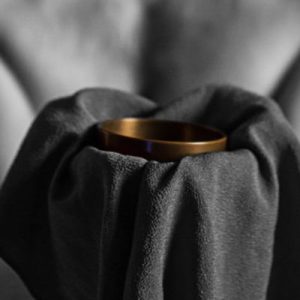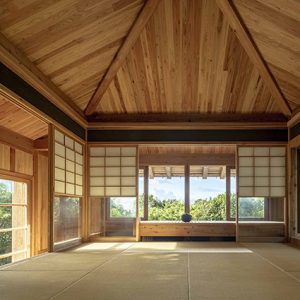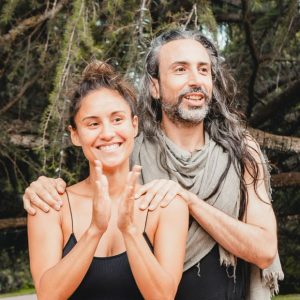Navakaraṇa Vinyāsa Hṛdayam
Introduction to the
Teacher Training Programme
Course Introduction
Course Options

Course Introduction
Navakaraṇa: self-transformation through physical and mental training
The first step in Navakaraṇa Method is to educate the practitioner (nava-karaṇi) at the physical and mental level.
For this reason, the nava-karaṇi has to complete the teacher training course Navakaraṇa Vinyāsa Hṛdayam (lit. The essentials of Navakaraṇa Vinyāsa). This course, also called “The Essentials” as it is extremely important to prepare body, mind and heart before going any further.
The course consists mainly of physical and mental training. Philosophy and Methodology are covered only partially as these topics are fully covered in Teaching Skill Training Course.
In this course the nava-karaṇi learns how to practice and teach a collection of 12 series (named Navakaraṇa Vinyāsa Mālā).
The Essentials Teacher Training Course is divided into four modules:
- Module 1: opening the body;
- Module 2: building strength and control;
- Module 3: developing flexibility and dynamism;
- Module 4: achieving control over complex and asymmetrical movements.
Each module consists of 108 hours. Upon completion, the practitioner (nava-karaṇi) graduates with 432 hours certified by the Navakaraṇa International Society.
Navakaraṇa Vinyāsa Mālā
Navakaraṇa Vinyāsa Mālā (lit. a collection of navakaraṇa compositions) consists of 36 sequences (krama) arranged into 12 series. The sequences (krama-s) include composition of movements and poses given in progression, allowing practitioners to personalise the practice according to their levels. Every sequence works on all parts of the body, but with a specific anatomical focus which varies every day according to the sequence. Dedicated students can complete the 4-module course in about three years. Once the practitioners have mastered the practice and teaching of the 12 series, they should follow a particular routine for practice and teaching. The routine is named “Navakaraṇa Krama Maṇḍala” (Cycle of Navakaraṇa’s sequences). This routine consists of 30 moon-days (tithi) equivalent to a lunar month (candramāsa). Learn more.
The 12 series are arranged according to the natural course of the moon cycle. Besides the vinyāsa practice, the practitioners should observe oil bath, fasting, rest days, silence and other mental and spiritual activities in accordance with the lunar month (candramāsa). The routine is given in the charts.
Navakarana multidisciplinary method
Navaraṇa Vinyāsa Hṛdayam integrates different branches of knowledge like anatomy, kinesiology, psychology, body-manipulation, musicotherapy, praṇic-healing, tantric techniques of yoga and kriyā. It provides a wide range of techniques for healing and transformation which can be personalised according to the individual.
The main objectives of this teacher trainng course are:
- creating lightness, flexibility, adaptability and strength of physique combined with purity and calmness of the mind;
- provide a wide and systematic syllabus for both practise and teaching;
- create community that supports every practitioner in personal and professional goals.
Upon competition of the 4-module course, practitioners can deepen the study and practice of Navakaraṇa with further courses such as:
- Life-style Course (Maulika Siddhānta);
- Advanced Series Course (Navakaraṇa Prakṛṣta);
- Teaching Skills Course (Navakaraṇa Śikṣā Paddhati)
- Movement Meditation Course (Navakaraṇa ZaZen)
- Philosophy Course (Navakaraṇa mīmāṃsā).
Practitioners who are ready to progress spiritually are guided individually.
Navakaraṇa synergist method
One of the most important principle of physical training is the rotation of anatomical focus. Rotation of anatomical focus means that if a practitioner worked on certain muscles on day-1; on day-2 he/she should work on a different group of muscles. Changing of anatomical focus allows recovery and healing of the body. This approach is different from modern yoga methods were practitioners are repeating the same series daily.
In the long term, repetition of the same practice weakens the body, making it prone to injuries. For this reason, Navakaraṇa series are arranged synergistically. The practitioner practises different series for two weeks. These series are complementary to each other. Let’s use the first three series of Navakaraṇa Vinyāsa Mālā as an example:
Day-1
- “group A-muscle” elongating;
- “group B-muscle” contracting;
- “C-muscle” minimal engagement;
Day-2
- “group A-muscle” contracting;
- “group B-muscle” minimal engagement;
- “group C-muscle” elongating;
Day-3
- “group A-muscle” minimal engagement;
- “group B-muscle” elongating;
- “C-muscle” contracting.
… and so on.
Synergistic approach means that the interaction of series produces a “combined-effect” which is greater than what it would be by practising each series separately.
The art and science of sequencing
Navakaṛana choreography of movements and poses traces its origins from Karaṇa and Nṛtta. These primitive sciences of movements and dance are much older than Haṭha-yoga and probably also of Yoga which was systematised only later.. We do not discuss in details Navakaraṇa’s choreography in this introduction as it is a vast and complex subject incomprehensible to anyone without having completed “Navakaraṇa Teaching Skills Course”. But there are some basic and important aspects of choreography which can help you comprehend Navakaraṇa more.
Viniyoga and kinaesthetic progression
“Breath-moment application” (viniyoga) are choreographed in order to provide a kinaesthetic progression into the moment/pose (karaṇa). Kinaesthetic progression means that the sequencing of each “breath-moment application” (viniyoga) has been created in order to bring awareness of the position and movement of the parts of the body by means of sensory organs (proprioceptors) in the muscles and joints.
Navakaṛana’s fundamental structure of the progression is given in six applications (viniyoga-s):
- inhale: provides identification of the base;
- exhale: provides identification of the lines and points of gravity;
- inhale: places body extremities in a particular orientation;
- exhale: generates focus or sensing of the elongating / contracting muscles;
- inhale: generates energy (of the movement or pose);
- exhale: creates awareness and control (kinaesthesia) over the movement/pose.
This is one of the main reasons why, in the Navakaraṇa method, all compositions (vinyāsa) are given with six counts.
Through Navakaraṇa Kinaesthetic progression, the practitioner can achieve sensing, feeling awareness and control over the movement/pose with minimal instruction from the teacher. It is an inner-practice. If the practitioner has memorised the sequence, no instructions are required.
Nava-karana system
The concept of karaṇa (unit of movement) is unique of Navakaraṇa method. The more you study and practise Navakaraṇa the more you realise how different this method is from any other system. A unit of movement (karaṇa) as three parts: entry, stay and exit. Navakaraṇa sequencing is not based on choreography of poses. It is based on choreography of entries and exits. What is generally referred as pose in other method, it is only a stay between entry and exit in Navakaraṇa.
According to Navakaraṇa there are two main categories of karaṇa (unit of movements): elongating (dairghya) and contracting (stambhana).
Elongating(dairghya) is further subdivided in
- pṛṣṭha-dairghya or posterior stretch;
- agra-dairghya or anterior stretch;
- pārśva-dairghya or side stretch;
- parivṛtta-dairghya or twisted stretch.
Contracting (dārḍhya) is further subdivided in:
- tejaskara or strengthening by contraction of core and forearms;
- aṅga-ādhāra or balancing on the limbs by stabilising different parts of the body;
- viparīta or inverted by immobilising the body.
Further:
- neutral (sama) is the condition where stretching and strengthening occur in perfect balance.
- necovery (punarnavīkāra) is the condition where stretching and strengthening occur at the minimal intensity.
Thus total number of categories and subcategories is nine. In order to have a complete practice the choreography of a sequence has to include all the nine (nava) units of movement (karaṇa). This is one of main reasons why this method is called Nava-karaṇa Vinyāsa (lit. composition of nine unit of movements).
Freedom of practice
The most important aspect of the practice is not the poses but how the nine units of categories are choreographed synergistically. For this reason, a navakaraṇi can change the pose as it more beneficial while maintaining the choreography of the nine category unchanged (in order to keep the synergy of the movements). To achieve the best result of of the practice it is very important to personalise the practice while keeping the kinaesthetic progression and synergetic arrangements. Personalised practice speeds up progress and reduces injures. It also enhances creativity and empowers the practitioners both at physical and mental level.
Personalisation based on body condition and proportion
The progression into the pose is built based on practitioner’s bodily proportion. This system is extremely accurate. Thus movements and poses are slighting different according to the individual’s anatomical body proportion. These principles and techniques are explained during the workshops and taught in details during the Teacher Training Courses.
Calligraphy and nomenclature
Navakaraṇa uses also a particular calligraphy and nomenclature for writing down the sequences. Navakaraṇa calligraphy which appears incompressible to anyone new to this method is actually clear and accurate to the navakaraṇi. In fact all the navakaraṇi does not need any drawing, photos or videos to understand the choreography of the sequence. This calligraphy allows practitioners and teachers to memories each viniyoga (or breath-movement application) of every sequence accurately and without forgetting any details.
The Navakaraṇa Class
Navakaraṇa class led by a senior teacher has very uniques and peculiar features that you cannot find anywhere else. The voice of the teacher is tuned (śruti) to a tānapūrā (traditional four-stringed lute). The instructions are given with hand-clapping or with a traditional wooden block instrument (karatāla). The class is lead with tempo (laya) and melody (svara). The teacher gives minimal instructions with tālam (rhythmic beat) and Sanskrit recitation tuned to a sound pitch (nāda) to facilitate harmonious flow, rhythmic breathing, concentration and mental clarity. What could appear very odds at first it is in reality a very ancient practice of teaching vinyāsa which is practically extinguished in the course of time with the only exception of the Navakaraṇa method which is keeping this ancient tradition still alive.
Graduating
Practitioners receive the first graduation, upon completion of Navakaraṇa Vinyāsa Hṛdayam (The Essentials). At this point, the navakaraṇi knows how to practice and teach thirty-six sequences. These sequences can be taught as regular vinyāsa class or can be taught as a de-construction class. A de-construction class explains one of the thirty-six vinyāsa sequences in detail. The kinaesthetic progression is given for every vinyāsa in the way that students can follow and memorise each breath-movement application (viniyoga). Students are also guided on how to progress into movements and personalise the poses according to their anatomical proportions. Experienced teachers can lead the traditional Navakaraṇa Vinyāsa classes, following the lunar-month routine.
Community
Another interesting aspect of Navakaraṇa method is the concept of a community (Kula). Navakaraṇa offers a methodology for practicing and teaching as well as a system of support which allows every Navakaraṇa teacher to conduct professional activities in symbiosis and harmony with the whole community.
Course Options
Navakaraṇa Vinyāsa Hṛdayam Teacher Training Syllabus is delivered in four different types of setting: Monastic TTC, Master TTC, Weekend TTC and Alumni TTC.
Course options
The Navakaraṇa Vinyāsa Hṛdayam’s syllabus is offered in different settings (options):
Master Teacher Training Course
The Master Teacher Training Course is the optimal programme for learning Navakaraṇa. It consists is a 2-day immersion programme (( hours per day for 12 days).
Monastic Teacher Training Course
The Monastic Teacher Training Course is a very unique programme fully immersed in the spirit of nature, learning, sharing and self-transformation. The course takes place in very remote areas aloof from any distraction. This programme is inclusive of food and accommodation. This course offers the optimal environment for learning while also retreating yourself. The upcoming Monastic Teacher Training Course is held in a monastery located in the mountains of Jangxi province (China). Registration is now open. View course details.
Weekend Teacher Training Course
The Weekend Teacher Training Course consists of long weekend programme (Friday, Saturday and Sunday). The course takes place in urban areas. The upcoming Weekend Teacher Training Course is held in Tokyo (Japan). Read more.
Alumni Teacher Training Course
This is a co-organised course where you learn first from a graduated alumnus throughout the year and finally review the whole programme in 3-day of Master Teacher Training. The upcoming Alumni Teacher Training Courses are hold in Spain (with alumnus Alessandra Oram) and in Shanghai (with alumnus Battsetseg Bat). Final 3-day master classes and exams are held in the respective locations with Dario Calvaruso. Registration and detail are coming soon. Read more.
For enquiries email info@navakarana.com
An Introduction to Navakaraṇa Method booklet:
English PDF – downloadable
Italian PDF – scaricabile
日本人 PDF – ダウンロード可能
中文 PDF – 可下载的
Master Teacher Training Retreats
with Dario Calvaruso
at Casa Erbane
Navakaraṇa Retreat Center
Module 3 and 4
with Dario Calvaruso
at Ma.Na Loft
Navakaraṇa Academy
Master Teacher Training in Retreat Format
Inclusive of food and accomodation
with Dario Calvaruso
Fuerteventura, Canary Island
Summer 2024 / Winter 2025
with Dario Calvaruso
Yakushima, Japan
Easter 2024
Alumni Teacher Training
Alumnus Teacher Training
Conducted by Alessandra
final review with Dario
Barcelona, Spain
